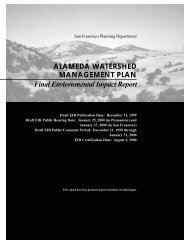Feasibility of Fish Passage at Alameda Creek Diversion Dam
Feasibility of Fish Passage at Alameda Creek Diversion Dam
Feasibility of Fish Passage at Alameda Creek Diversion Dam
You also want an ePaper? Increase the reach of your titles
YUMPU automatically turns print PDFs into web optimized ePapers that Google loves.
<strong>Feasibility</strong> <strong>of</strong> <strong>Fish</strong> <strong>Passage</strong> <strong>at</strong> <strong>Alameda</strong> <strong>Creek</strong> <strong>Diversion</strong> <strong>Dam</strong>the need to maintain the specified approach velocity, the install<strong>at</strong>ion and use <strong>of</strong> fish screens <strong>at</strong> ACDDwould result in a reduction in the amount <strong>of</strong> w<strong>at</strong>er available for diversion to Calaveras Reservoir for use asmunicipal w<strong>at</strong>er supply.It is estim<strong>at</strong>ed th<strong>at</strong> a maximum screen area <strong>of</strong> 1,400 square feet could be accommod<strong>at</strong>ed outside <strong>of</strong> thesediment channel <strong>at</strong> the ACDD. With any screening installed <strong>at</strong> ACDD structural supports, baffles, andother infrastructure would cause some structural blinding. Structural blinding typically reduces theeffective screen area by 20 or 30 percent. To account for anticip<strong>at</strong>ed structural blinding, a reduction <strong>of</strong>approxim<strong>at</strong>ely 20 percent was applied to the estim<strong>at</strong>ed maximum screen area for a reduced screen area <strong>of</strong>1,120 square feet. Based on the rel<strong>at</strong>ionship shown in Figure 5-1, after accounting for structural blinding,the estim<strong>at</strong>ed maximum flow r<strong>at</strong>e <strong>of</strong> the diversion would be limited to approxim<strong>at</strong>ely 370 cfs. Bycomparing daily average flows in <strong>Alameda</strong> <strong>Creek</strong> with the estim<strong>at</strong>ed maximum diversion flow r<strong>at</strong>e <strong>of</strong>370 cfs, the potential reductions in annual w<strong>at</strong>er diversions with screening <strong>at</strong> the ACDT can be estim<strong>at</strong>ed.At the time estim<strong>at</strong>es <strong>of</strong> the cost <strong>of</strong> this lost w<strong>at</strong>er diversion opportunity were first developed, thehydrologic record for upper <strong>Alameda</strong> <strong>Creek</strong> (USGS 11172945) extended only from 1995 to 2004. Thisis a rel<strong>at</strong>ively short period <strong>of</strong> record and may not accur<strong>at</strong>ely characterize the temporal distribution <strong>of</strong>unimpaired flows th<strong>at</strong> could potentially occur above ACDD. To more accur<strong>at</strong>ely predict the frequencyand magnitude <strong>of</strong> unimpaired flows th<strong>at</strong> could potentially be available during the diversion period(November through April), a synthetic hydrology was produced based on a correl<strong>at</strong>ion with theunimpaired daily average flows recorded <strong>at</strong> the Arroyo Hondo gage (USGS 11173200) from 1969 to1981 and 1995 to 2004 (no flow d<strong>at</strong>a are available from Arroyo Hondo for the period from 1982through 1994). This analysis was completed to estim<strong>at</strong>e potential w<strong>at</strong>er yields above ACDD over abroader range <strong>of</strong> hydrologic conditions by extending the period <strong>of</strong> record from 10 years to 24 years.Appendix B contains a description <strong>of</strong> the model selection process and detailed flow d<strong>at</strong>a.In support <strong>of</strong> the limited record <strong>of</strong> measured flow d<strong>at</strong>a for upper <strong>Alameda</strong> <strong>Creek</strong>, predicted dailyaverage flows from the model described in Appendix B were used to estim<strong>at</strong>e an unimpaired flow foreach day <strong>of</strong> each year in the simul<strong>at</strong>ed period. These daily unimpaired flows were then used tocalcul<strong>at</strong>e the difference in potential diversion volumes <strong>at</strong> ACDD between screened and unscreeneddiversions during the typical ACDD oper<strong>at</strong>ional period <strong>of</strong> November through April.Table 5-2 is a comparison <strong>of</strong> the total annual (w<strong>at</strong>er year) diversion with and without screening, aspredicted by the model for simul<strong>at</strong>ed flows for the time periods 1969 through 1981 and 1995 through2004. The following list describes each column in the table.■■■Total Flow represents the total simul<strong>at</strong>ed flow in upper <strong>Alameda</strong> <strong>Creek</strong> for the period <strong>of</strong> recordduring the November-through-April w<strong>at</strong>er diversion time period.Unimpaired <strong>Diversion</strong> (without screens) represents the estim<strong>at</strong>ed amount <strong>of</strong> w<strong>at</strong>er th<strong>at</strong> could bediverted under simul<strong>at</strong>ed flows if all flows up to 650 cfs were diverted through ACDT during theNovember-through-April time period.Unscreened <strong>Diversion</strong> with Schedule B Bypass Flows represents the estim<strong>at</strong>ed amount <strong>of</strong> w<strong>at</strong>erth<strong>at</strong> could have been diverted under simul<strong>at</strong>ed flows if bypass flows consistent with the SFPUCproposednormal w<strong>at</strong>er year instream flow schedule 10 (Section 2.3.2.2) were bypasseddownstream <strong>at</strong> ACDD, while other flows up to 650 cfs were diverted during the Novemberthrough-Apriltime period.10 As referred to here and subsequently in this memorandum, the term “SFPUC-proposed instream flow schedule” alsoincludes the WSIP Final PEIR mitig<strong>at</strong>ion flows detailed in Section 2.3.2.2.ACDD <strong>Passage</strong> June 2009 Page 5-4








